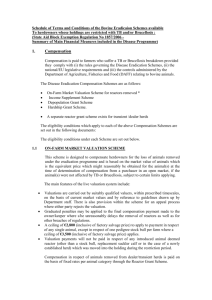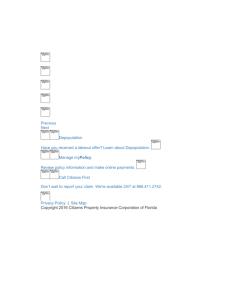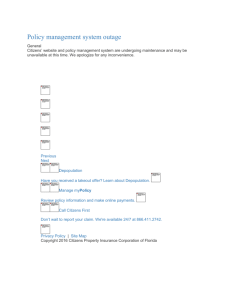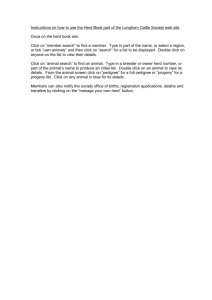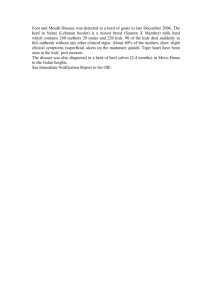Schedule of Terms and Conditions of the Disease Eradication
advertisement
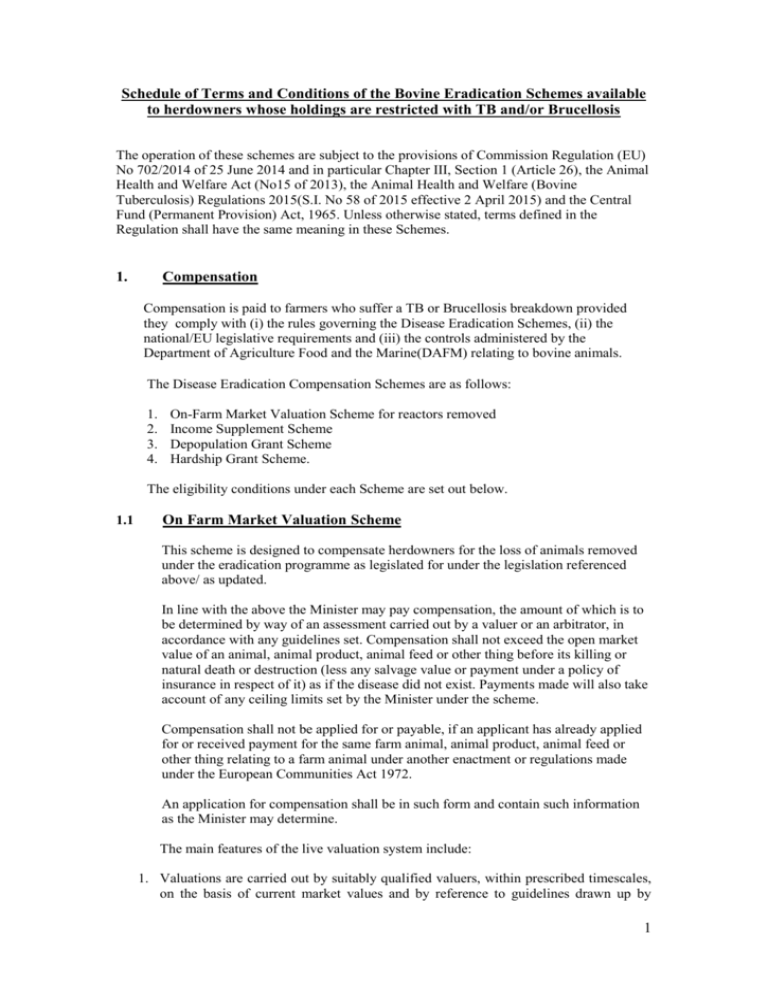
Schedule of Terms and Conditions of the Bovine Eradication Schemes available to herdowners whose holdings are restricted with TB and/or Brucellosis The operation of these schemes are subject to the provisions of Commission Regulation (EU) No 702/2014 of 25 June 2014 and in particular Chapter III, Section 1 (Article 26), the Animal Health and Welfare Act (No15 of 2013), the Animal Health and Welfare (Bovine Tuberculosis) Regulations 2015(S.I. No 58 of 2015 effective 2 April 2015) and the Central Fund (Permanent Provision) Act, 1965. Unless otherwise stated, terms defined in the Regulation shall have the same meaning in these Schemes. 1. Compensation Compensation is paid to farmers who suffer a TB or Brucellosis breakdown provided they comply with (i) the rules governing the Disease Eradication Schemes, (ii) the national/EU legislative requirements and (iii) the controls administered by the Department of Agriculture Food and the Marine(DAFM) relating to bovine animals. The Disease Eradication Compensation Schemes are as follows: 1. 2. 3. 4. On-Farm Market Valuation Scheme for reactors removed Income Supplement Scheme Depopulation Grant Scheme Hardship Grant Scheme. The eligibility conditions under each Scheme are set out below. 1.1 On Farm Market Valuation Scheme This scheme is designed to compensate herdowners for the loss of animals removed under the eradication programme as legislated for under the legislation referenced above/ as updated. In line with the above the Minister may pay compensation, the amount of which is to be determined by way of an assessment carried out by a valuer or an arbitrator, in accordance with any guidelines set. Compensation shall not exceed the open market value of an animal, animal product, animal feed or other thing before its killing or natural death or destruction (less any salvage value or payment under a policy of insurance in respect of it) as if the disease did not exist. Payments made will also take account of any ceiling limits set by the Minister under the scheme. Compensation shall not be applied for or payable, if an applicant has already applied for or received payment for the same farm animal, animal product, animal feed or other thing relating to a farm animal under another enactment or regulations made under the European Communities Act 1972. An application for compensation shall be in such form and contain such information as the Minister may determine. The main features of the live valuation system include: 1. Valuations are carried out by suitably qualified valuers, within prescribed timescales, on the basis of current market values and by reference to guidelines drawn up by 1 Department staff. There is also provision within the scheme for an appeal process where either party rejects the valuation. 2. Graduated penalties may be applied to the final compensation payment made to the owner/keeper where s/he unreasonably delays the removal of reactors as well as for other breaches of regulations. 3. A ceiling of €2,800 (inclusive of factory salvage price) to apply to payment in respect of any single animal, except in respect of one pedigree stock bull per farm per breakdown episode where a ceiling of €3,500 (inclusive of factory salvage price) applies. Where applicable account is also taken of any amounts which Herdowners may receive from private insurance for bovine animals removed as reactor. 4. Valuation payments will not be paid in respect of any introduced animal deemed reactor. Certain exceptions apply where permission has been given in the case of: (i) a replacement stock bull(s); (ii) emergency replacement suckler calf; (iii) animals moved in to a newly established herd; (iv) movement of animals into a herd contiguous to a High risk breakdown suspended pending test(specific time constraints apply); (v) cases where approval has been given for movement home to a restricted herd of a farmers own test negative animals (welfare cases). Failing by the owner/keeper to co-operate with Veterinary Inspectors or authorised officers in carrying out their duties under the Diseases Eradication Schemes may result in reduced valuation amount paid. 1.2 Depopulation Grant An owner/keeper whose herd is depopulated (totally or partially) in the interest of disease control may qualify for a Depopulation Grant, which is designed to compensate farmers for income lost during the rest period. Depopulation Grants are paid for each animal removed in the depopulation measure and for those removed as reactors since the holding was restricted, on condition that the owner/keeper agrees to depopulation at the time specified by the Regional Veterinary Office (RVO). Movement of any animals into a restricted herd is prohibited except with the written permission of the RVO. Depopulation grants are not generally payable on animals moved onto the holding during the restriction period if these animals are subsequently deemed reactors although some exceptions to this rule may apply. Depopulation Grants are paid in respect of each month of the rest period specified by the RVO. The Depopulation Grant rates currently in force are as follows: TB Animal Stable Feedlot/Dealer Brucellosis TB and Brucellosis Rate (€) Standard rate (€) Standard rate plus(€) (i) Dairy Cows / In-Calf Heifers/Pedigree Bulls > 12 months 228.52 126.97 228.55 Nil (ii) Other Cows / In-Calf Heifers 126.96 126.97 126.97 Nil 2 (iii) Other Animals 76.16 38.09 76.18 Nil Note: Depopulation Grant rates quoted above represent the maximum available in respect of a 4 month rest period following depopulation. Pro rata deductions or increases will be made if the rest period after depopulation is less than or more then 4 months. 1.3 Income Supplement Income Supplement is payable in cases where disease breakdown results in the removal of more than 10% of animals in a herd and where depopulation is not deemed appropriate. Payment is in respect of each animal removed as a reactor from a herd, subject to a maximum of 100 animals qualifying for payment. A herdowner will not be eligible for payment of Income Supplement with effect from the date cattle are moved into a restricted herd for the remainder of the restriction period. Some exceptions to this rule may apply but are subject to the RVO having given permission to move the animals into the restricted herd. Income Supplement eligibility will also cease in the event of: 1. The owner/keeper failing to co-operate with Veterinary Inspectors or authorised officers in carrying out their duties under the Diseases Eradication Schemes. 2. Depopulation (total or partial) of the herd being deemed appropriate by the Department. 3. De-restriction of the holding. The Income Supplement Monthly rates currently in force are as follows: Animal Stable Feedlot/Deale r TB Rate (€) Brucellosis Rate (€) Rate (€) (i) Other Cows 38.09 38.09 NIL (ii) Dairy Cows & Other Animals 25.39 25.39 NIL Note: Specific conditions attach to the qualification for and cessation of Income Supplement payment. In particular, payment is in respect of whole months in arrears and subject to payment eligibility date and, accordingly, when eligibility ceases, a pro rata payment will not issue in respect of any remaining part month. Note also that payment may not be made where the herd owner fails to have the Reactor Re-test carried out within the specified time. 3 1.4 Hardship Grant The Hardship Grant eligibility period runs from 1 November to 30 April. This Scheme is designed to alleviate the costs difficulty of some owner/keepers whose holdings are restricted on foot of a herd re-test and where animals are retained and fed during periods of restriction. Potentially eligible owner/keepers must meet certain conditions including requirements that they (i) must not have any income from milk sales and (ii) must not have any off-farm income. The Grant may provide eligible owner/keepers with a payment of up €250.00 per month for a period not exceeding 4 months within the period 1 November to 30 April of the following year. Main overall terms and conditions of Disease Eradication Compensation Schemes 1. The Department’s Booklet Compensation arrangements for TB and Brucellosis “Important Information for the Owner/Keeper” provide useful information in relation to the valuation arrangements, Income Supplement and Depopulation Grant eligibility requirements, rates payable, etc. 2. Entitlement to the payment of compensation is conditional on compliance with the provisions of the Animal Health and Welfare Act (No15 of 2013), the Animal Health and Welfare (Bovine Tuberculosis) Regulations 2015(S.I. No 58 of 2015 effective 2 April 2015) and any other relevant orders made under it, with regard to Animal Remedies legislation, with testing, movement, identification, bio security and other controls laid down under the Disease Eradication Schemes including the legal requirement not to treat cattle prior to testing unless urgently required and other national/EU legislative requirements and controls relating to bovine animals administered by the Minister for Agriculture, Food and the Marine. 3. The Minister may refuse payment of compensation, in whole or in part, where a owner/keeper does not satisfy the aforementioned provisions or where the Minister is satisfied that the owner/keeper has failed to co-operate with authorised officers or Veterinary Inspectors of the Department in carrying out their duties under the Schemes. 4. A Tax Clearance Certificate is required if a compensation payment is over €10,000 in a 12 month period. 5. In accordance with the payment targets agreed on Direct Payments to Farmers under the Charter of Rights for Farmers, payment of TB and Brucellosis, compensation will normally be made within 2-3 weeks of the date of receipt of the required back-up documentation from the owner/keeper and the meat plant. The required back up documentation for valuation payment is detailed in the “Compensations arrangements for TB and Brucellosis – Important Information for Farmers”. 6. The Department will pay compensation, as processed by the Regional Veterinary Offices (RVOs), in accordance with the provisions of the compensation regime. Appeal mechanisms with regard to penalties applied to /or compensation payments withheld in full / other general information are detailed in the booklet “Compensations arrangements for TB and Brucellosis – Important Information for Farmers”. 4 7. Compensation received by farmers from the ERAD compensation scheme and under an insurance policy may not exceed the actual losses incurred. 8. The compensation arrangements and rates are adjusted from time to time in consultation with the farm organisations. 9. Expenditure on compensation schemes under the TB and Brucellosis Eradication Schemes is subject to inspection checks or audit, from time to time, by officials of DAFM, Office of the Comptroller and Auditor General and the European Commission. 10. If any of the terms and conditions are found not to have been fully met, repayment of all or any part of the grant may be required, as deemed reasonable and appropriate by the Department. 2.0 Aid in accordance with Commission Regulation (EU) No. 702/2014 Under EU Regulation 702/2014, eligible herdowners who are defined as SME’s under the Regulation, whose holdings are restricted as a result of *reactor animals being identified in the herd and where other animals are retained and fed during this restriction are eligible to apply under this scheme. Aid granted under Article 26 of Commission Regulation (EU) No. 702/2014 must abide by the conditions set out in paragraphs 2 to 13: Aid shall only be paid:[para 2] (a) in relation to animal diseases or plant pests for which Union or national rules exist, whether laid down by law, regulation or administrative action; and (b) as part of: (i) a public programme at Union, national or regional level for the prevention, control or eradication of the animal disease or the plant pest concerned; or (ii) emergency measure imposed by competent authority; or (iii) measures to eradicate or contain a plant pest implemented in accordance with Council Directive 2000/29/EC The programme and measures referred to in point (b) shall contain a description of the prevention, control or eradication measures concerned. The aid shall not relate to measures in respect of which Union legislation provides that the cost of such measures is to be borne by the beneficiary, unless the cost of such measures is entirely offset by compulsory charges on the beneficiaries. [para 3] As regards animal diseases, the aid shall only be granted in respect of animal diseases referred to in the list of animal diseases established by the World Organisation for Animal Health or the animal diseases and zoonoses listed in Annexes I and II to Regulation (EU) No YYY/2014 of the European Parliament and of the Council (1).[para 4] Aid shall be paid directly to the undertaking concerned or to a producer group or organisation of which that undertaking is a member. Where the aid is paid to a producer group or organisation, the amount of aid shall not exceed the amount of aid to which that undertaking is eligible. [Para 5] 5 Aid schemes shall be introduced within three years from the date of the occurrence of the cost or loss caused by the animal disease or plant pest. Aid shall be paid out within four years from that date.[Para 6] In the case of prevention measures, the aid shall cover the following eligible costs: [para 7] (a) health checks; (b) analyses, including in-vitro diagnostics; (c) tests and other screening measures, including TSE and BSE tests; (d) the purchase, storage, administration and distribution of vaccines, medicines, substances for the treatment of animals and plant protection products; (e) the preventive slaughtering or culling of animals or the destruction of animal products and plants and the cleaning and disinfection of the holding and equipment. In the case of control and eradication measures, the aid shall cover the following eligible costs: [para 8] (a) tests and other screening measures in case of animal diseases, including TSE and BSE tests; (b) the purchase, storage, administration and distribution of vaccines, medicines, substances for the treatment of animals and plant protection products; (c) the slaughter or culling and destruction of animals and the destruction of products linked to them, or destruction of plants, including those that die or are destroyed as a result of vaccinations or other measures ordered by the competent authorities and the cleaning and disinfection of the holding and equipment. In the case of aid to make good the damage caused by animal diseases or plant pests, compensation shall be calculated only in relation to: [para 9] (a) the market value of the animals slaughtered or culled or that have died or the products, linked to them, or the plants destroyed: (i) as a result of the animal disease or the plant pest; (ii) as part of a public programme or measure as referred to in paragraph 2(b). That market value shall be established on the basis of the value of the animals, products and plants immediately before any suspicion of the animal disease or plant pest arose or was confirmed. (b) the loss of income due to quarantine obligations, difficulties in restocking or replanting and obligatory crop-rotation imposed as part of a public programme or measure as referred to in paragraph 2(b). That amount shall be reduced by any costs not directly incurred due to the animal disease or plant pest which would otherwise have been incurred by the beneficiary. The aid to make good the damage caused by animal diseases or plant pests shall be limited to costs and damage caused by animal diseases and plant pests for which the competent authority: [Para 10] (a) has formally recognised an outbreak, in the case of an animal disease; or (b) has formally acknowledged their presence, in the case of plants pests. Aid in relation to the eligible costs referred to in paragraph 7 and 8 shall be granted in kind and shall be paid to the provider of the prevention and eradication measures. [Para 11] 6 By way of derogation from the first subparagraph of this paragraph, aid in relation to the eligible costs referred to in the following paragraphs may be granted directly to the beneficiary on the basis of reimbursement of the real costs incurred by the beneficiary: (a) paragraphs 7(d) and 8(b) in the case of animal diseases or plant pests; and (b)paragraphs 7(e) and 8(c) in the case of plant pests and for the cleaning and disinfection of the holding and equipment. No individual aid shall be granted where it is established that the animal disease or the infestation with the plant pest was caused deliberately or by the negligence of the beneficiary. [Para 12] The aid and any other payments received by the beneficiary, including payments under other national or Union measures or insurance policies for the same eligible costs as referred to in paragraphs 7, 8 and 9 shall be limited to 100 % of the eligible costs. [Para 13] The annual report, as referred to in Chapter III of Regulation (EC) No 794/2004, on the application of this Regulation shall contain the information concerning animal diseases or plant pest as referred to in Article 26. [Article 12] Aid under this Scheme shall not be cumulated with any de minimis aid in respect of the same eligible costs if such cumulation would result in an aid intensity exceeding those laid down in the Regulation as referred to in Article 8. This Regulation shall not apply to aid to undertakings in difficulty with the exception of: [Article 1, Para 6] aid for the costs of the eradication of animal diseases in accordance with Article 26(8) and aid for removal and destruction of fallen stock in accordance with Article 27(1)(c), (d) and (e); (b) aid for the following event provided that the undertaking became an undertaking in difficulty due to losses or damages caused by the event in question: aid for the costs of the eradication of plant pests and for making good the damage caused by animal diseases and plant pests in accordance with Article 26(8) and (9); 2.1 Payment for herd tests A key measure for eradication of the disease involves regular testing of herds and, in order to comply with the EU Trade rules, an annual herd testing programme is in place involving the testing of all eligible animals in every herd every year. Terms and Conditions for Private Veterinary Practitioners Farmers are responsible for arranging annual herd tests with their private veterinary practitioners (PVPs) within timescales prescribed by the Department. The general rule is, that a farmer will make payment for the TB test to the veterinary practitioner carrying out the test except where reactors are disclosed. The Department will ordinarily, pay for any second or subsequent herd level TB test, completed within the 12-month period. Payment for such tests will be made directly to the PVP and not to the farmer. The authorised private veterinary practitioner (PVP) must at all times comply with the Conditions of Contract (ER68) and, in particular, commit formally and adhere 7 strictly to the instructions, terms and conditions as laid down in Document ER4 ‘Conditions and instructions for Veterinary Practioners involved in testing and sampling under Bovine Tuberculosis and Brucellosis Monitoring Programme’s. Failure to comply with the instructions, terms and conditions, including those relating to equipment, performance of test, record keeping and other administrative procedures, may, depending on the nature of the infringement, result in sanction appropriate to the infringement, up to and including the immediate withdrawal of approval to conduct Tuberculin testing and Brucellosis sampling. 2.2 Reactor collection service This scheme provides for the removal and transport of TB and Brucellosis reactors from the holding free of charge to slaughter plants and enhances the control of the spread of the disease. Terms and Conditions for Reactor Collection Service. The service is operated by the Department on the basis of contracts awarded to private hauliers following a tender procedure. The contract is for a 2-year period and the conditions applicable are as follows: 1. The transportation of animals must comply with the provisions of Council Regulation (EC) 1 of 2005 on the protection of animals during transport and related operations and S.I. No. 675 of 2006. This Regulation requires any transporter, who transports animals on journeys over 65km for commercial purposes, to be authorised by the Department, and to undergo training and hold a certificate of competence. 2. The provisions of the Road Traffic Act 1961-2006, in relation to a valid driving licence, vehicle tax and insurance and certificate of roadworthiness must be adhered to. Haulage contractors are also obliged to provide adequate insurance cover against injury or death to animals in transit. No liability shall attach to the DAFM in such instances. 3. The haulier must have a fax/email address in order to receive advance itinerary notification regarding animal collection form the local RVO. 4. The haulier must have a mobile phone so that he/she can be contacted by the Department at any time from the start of collection of animals to delivery at the slaughter plant. 5. The haulier must collect the ER26 (movement permit) or the equivalent appropriate permit from the keeper and check that the animals presented for collection on the farm match the identification of the animals listed on the ER26 (movement permit) and on the itinerary list, and that the animals are fit for transport from a welfare perspective. 6. The haulier is responsible for collecting all the animals listed on the movement permit and must immediately contact the RVO in the event that any animals listed on the movement permit cannot be collected or are unfit for transport. 7. In order to minimise the risk of disease spread, vehicles must be equipped with a slurry tank and a container of approved disinfectant and be properly cleansed and 8 disinfected, bearing in mind the particular disease condition involved, before collection and after delivery of animals. Contractors may at any time prior to or during a transport operation be inspected to ensure compliance with this condition and/or be asked to provide evidence of availability and use of disinfectant. A log book with the dates of disinfection should be kept by the haulier and be available for inspection by an authorized officer of the DAFM. 8. The animals must be transported directly from the farm of origin, upon production of the appropriate movement permit by the keeper or haulier, to the nominated premises on the day of collection without being set down in any other location. In a multiply pick-up operation any Brucellosis reactors must always be collected last. 9. Subject to an animal(s) being unfit for transport for welfare reasons, all animals listed on the itinerary must be collected and delivered to the nominated premises. Vehicles transporting animals under this contract must not in any circumstances enter onto any holding, which is not listed on the collection itinerary provided by the RVO. 10. Hauliers must permit the Department Inspector/Authorised Officer to carry out inspections of the collection and delivery service at farm level, or at the time of delivery of the animals to the nominated premises. 11. The haulier must sign the ER26 on delivery of the reactor animals to the slaughter plant. 12. In the event of a breakdown during an itinerary, the onus is on the haulier to arrange suitable alternative transport to deliver the animals to the designated premises on the same day. Such transport must comply with all the conditions contained in this schedule. 13. The haulier must endeavour to deliver animals to the designated premises between 08.00 and 17.00 hrs Monday to Friday inclusive, other than when explicitly directed by DAFM. The District Superintendent at the RVO will establish with premises management and the Veterinary Officer-in-charge the latest time for delivery of the animals. 14. The successful haulier must present a current C2 certificate. In the absence of a C2 certificate the Department will deduct tax at the rate of 35% from payments to hauliers. Furthermore where invoices/claims submitted exceed €10,000 (inclusive of VAT) within any twelve month period payments will not issue until a current C2 Certificate is presented. 15. Payment will be made in accordance with the provisions of the Prompt Payment of Accounts Act, 1997 and 2003, on submission by the haulage contractor of satisfactorily completed itinerary forms indicating number of animals collected, the kilometres covered, the number of collection points and the amount claimed. 16. Potential contractors have a legal obligation to pay sub-contractors in accordance with the Prompt Payment of Accounts Act, 1997 and 2003 (no. 31 of 1997) 17. Contractors must confirm that they will comply with statutory provisions relating to minimum pay, legally binding industrial or sectorial agreements and relevant health and safety issues for all staff employed by them for the purpose of fulfilling this contract. 9 18. The Department will be at liberty to terminate a contract in the event of any of the conditions of contract being breached for it the service being provided is found to be unsatisfactory. The Department shall also reserve the right to review all aspects of the reactor collection operation should the need arise. 10
